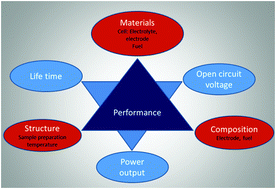Challenges in developing direct carbon fuel cells
Abstract
A direct carbon fuel cell (DCFC) can produce electricity with both superior electrical efficiency and fuel utilisation compared to all other types of fuel cells. Although the first DCFC prototype was proposed in 1896, there was, until the 1970s, little sustained effort to investigate further, because of technology development issues. Interest in DCFCs has recently been reinvigorated as a possible method of replacing conventional coal-fired power plants to meet the demands for lower CO2 emissions, and indeed for efficient utilisation of waste derived chars. In this article, recent developments in direct carbon conversion are reviewed, with the principal emphasis on the materials involved. The development of electrolytes, anodes and cathodes as well as fuel sources is examined. The activity and chemical stability of the anode materials are a critical concern addressed in the development of new materials. Redox media of molten carbonate or molten metal facilitating the transportation of ions offer promising possibilities for carbon oxidation. The suitability of different carbon fuels in various DCFC systems, in terms of crystal structure, surface properties, impurities and particle size, is also discussed. We explore the influence of a variety of parameters on the electrochemical performance of DCFCs, with regard to their open circuit voltage, power output and lifetime. The challenges faced in developing DCFCs are summarised, and potential prospects of the system are outlined.



 Please wait while we load your content...
Please wait while we load your content...